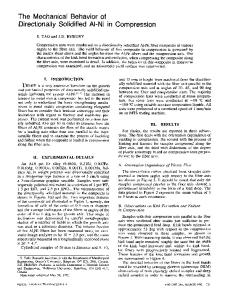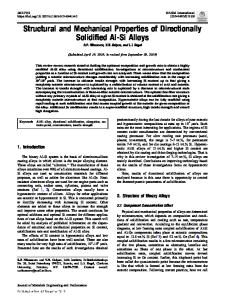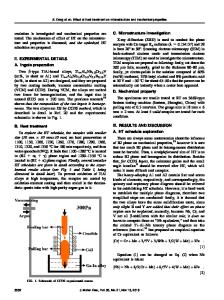Mechanical Behavior and Microstructure Characteristics of Directionally Solidified TWIP Steel
- PDF / 4,380,758 Bytes
- 12 Pages / 593.972 x 792 pts Page_size
- 89 Downloads / 413 Views
past decade, twinning-induced plasticity (TWIP) steels have been paid much attention due to their outstanding mechanical properties, unique microstructural behavior, and potential applicability in the transportation industry.[1] As a member of the second generation of advanced high-strength steels (AHSSs), TWIP steels exhibit high strength levels of 500 to 1200 MPa, strain hardening (n > 0.35), and 60 to 95 pct elongation to fracture.[2–12] Compared with the third-generation AHSSs, which are currently under development, TWIP steels cost much more, but they have a higher level of strength and ductility ranges.[3] These excellent mechanical prosperities make them attractive for application in the automotive industry as structural components for obtaining better fuel economy and passenger safety by the reduced vehicle mass and enhanced energy absorption. However, in commercial applications, other than cost, one problem with TWIP steels is the ability to stamp them into useful components. Although some researchers have pointed out that TWIP steels exhibit excellent formability,[13–15]
DAN WANG and KUN WANG, Assistant Researchers, and FUSHENG HAN, Professor, are with the Key Laboratory of Materials Physics, Institute of Solid State Physics, Chinese Academy of Sciences, Hefei 230031, P.R. China. Contact e-mail: fshan@issp. ac.cn JIANFENG MAN and JIANZHONG YANG, Senior Researchers, are with the China Academy of Space Technology, Beijing 100094, P.R. China. Manuscript submitted November 4, 2014. METALLURGICAL AND MATERIALS TRANSACTIONS A
the press capacity may not be available to achieve the needed strength lengths because of the extreme ductility. The excellent comprehensive mechanical properties originate from the unique twinning behavior during plastic deformation as well as from the interaction between dislocation gliding and twinning. It has been known that when the stacking fault energy (SFE) of austenitic steels falls in the range of 18–45 mJ/m2, the deformation will be controlled by the formation of twins. The twins are suggested to act as strong obstacles to dislocation gliding, reducing the dislocations mean free path and thus giving rise to a high strain-hardening rate and delayed necking.[16] As a result, an excessively large and uniform deformation is produced.[6] It has been demonstrated that the orientation and size of grains have important influences on the strain-hardening behavior of TWIP steels, while in Fe-Mn-C, dynamic strain aging (DSA), interpreted as the interaction between C-Mn octahedral clusters and mobile dislocations, is also suggested to attribute to the high strain-hardening rate.[16–20] Yang et al. reported that the direction h111i was the most favorable grain orientation for producing twinning variants and high strain hardening.[21] Bouaziz et al. pointed out that in rolled TWIP steels, the anisotropy of the sample, coming from the loading axis parallel or perpendicular to the rolling direction, would lead to different strain-hardening rates. It is because the texture evolution in anisotropi
Data Loading...











